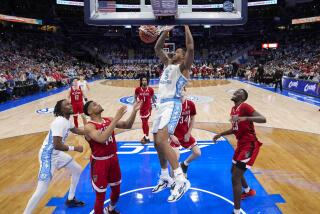Commentary : Why Not Let All 291 Teams Into the NCAA Tournament?
- Share via
KANSAS CITY, Mo. — The temptation very often after the NCAA basketball championship game is to sneak onto the court with a crowbar, crack open the boards and search for the horseshoes and four-leaf clovers that surely must be hidden somewhere. How else to explain how the colleges have managed to get so lucky with their showcase games?
They are as greedy and lap-dog obedient to television as the NFL. Their season is getting about as redundant as the NBA’s and NHL’s. If fights continue at this season’s pace, that third official might have some use after all--to count after the knockdowns. Tell me you couldn’t imagine Billy Tubbs as a pro rasslin’ manager?
Consider this: The only reason for holding postseason conference tournaments, other than money, is so a halfway decent team can win it and bump a slightly better one from the NCAA field. If the NBA tried to make its hired hands do what the Atlantic Coast Conference forced onto Duke about a month ago--play late Friday night, play the next afternoon and then play early the next afternoon for the title--there would be a strike before the first tipoff. And rightly so.
The colleges could be as pure as they claim by eliminating the postseason conference nonsense and letting everybody, all 291 Division I schools, into the NCAA’s big show. In the same weekend now devoted to the conference tournaments, first-round games, assuming the proper adjustments required to create a 256-team draw, would get the NCAA playoffs exactly where they are now: 64 schools.
The early-round regional games would be on a Friday. The 256 teams would be whittled to 128 on Saturday, and by half again on Sunday. This would give each college some of the television loot, relieve some of the inordinate pressure on coaches, perhaps drive Dick Vitale into dribble-lock and out of constant earshot for a while. Who can argue with those noble goals?
What happens now is Oklahoma whips Kansas twice during the regular season, fair and square, home and away, and doesn’t get a chance to do it again in the conference silliess because the Jayhawks are lousy enough at the time to be beaten by Kansas State in the semifinals. Both teams, the 35-victory Sooners and the 11-loss Jayhawks, get matched for the NCAA title--and the game is so good nearly everybody forgets the prior inequities.
Kemper Arena was another enchanting gym last Monday night. While using Sooners as foils and teammates as necessary props, Danny Manning raced past Larry Bird, Magic Johnson, Wilt Chamberlain, Jerry West and everybody else except Bill Walton in our minds.
Walton’s 44-point performance, on 21-of-22 accuracy from the field, remains the best in an NCAA final. Manning missed almost half his 26 shots--and had one rejected before it left his hand. But that stuff by Stacey King actually enhanced Manning’s impression, because it helped reinforce the fact that those 31 points and 18 rebounds did not come against stiffs.
The Sooners are very good. They were a solid and reasonable pick by those who believe no team without at least three likely pro players can survive the NCAA tournament. To its credit, Kansas had to shoot lights-out, 71%, simply to gain a 50-50 tie at the half.
Ed Steitz, who as editor of the men’s basketball rules committee helps fine-tune the college game, called that two-team sprint “the most exciting half of (NCAA) basketball I’ve seen in 36 years.” Films might cause him to agree with an opinion here: The officiating was terrible.
To offer some perspective on Manning, Bill Russell had 23 and 26 points in San Francisco’s back-to-back championships in the mid-’50s; Chamberlain had 23 points and 14 rebounds in a three-overtime losing effort for Kansas against North Carolina in 1957. Magic had 24 points and Larry Bird 19 (seven for 21 from the field) and 13 rebounds in their 1979 showdown.
Jack Givens had 41 points for Kentucky in 1978, but the lingering memory is of him slipping into gaps in Duke’s zone defense and his teammates feeding him for open jumpers. Manning was creative close to the basket and, equally important, against the frequently suffocating Sooner press; Manning was the major reason Oklahoma had almost no second shots; Manning had enough scoops and flip hooks in the open court and the cluttered area near the basket to keep fans contented until the NBA playoffs reach the conference semifinals.
Fine as he was, Manning did have help. Piper, Kevin Pritchard, Milt Newton and Clint Normore were a combined 19 for 22. Bird had nothing remotely close to that sort of cooperation from his teammates. Neither did Indiana State have the sort of bench wisdom Larry Brown provided Kansas.
All brilliance in sports usually means is that every guess works. Still, Brown orchestrated that victory as few others have in similar situations. He started a semi-stall when the Jayhawks were behind by three points, at 68-65. For stunning contrasts, Kansas scored 50 points in the first 20 minutes and 16 the final 10.
Brown’s most important tactic, of course, came not during pregame meetings or the game itself. The maneuver that brought Kansas its second NCAA title was the one--five years earlier--that brought Manning’s father back into high-level basketball. Lots of ugly talk followed Brown hiring Ed Manning as an assistant; I thought it inspired at the time--and still do.
Of recruiting his son, the practical-minded father said: “We wanted to build a program, and we couldn’t think of a better way to do it.”
More to Read
Go beyond the scoreboard
Get the latest on L.A.'s teams in the daily Sports Report newsletter.
You may occasionally receive promotional content from the Los Angeles Times.










